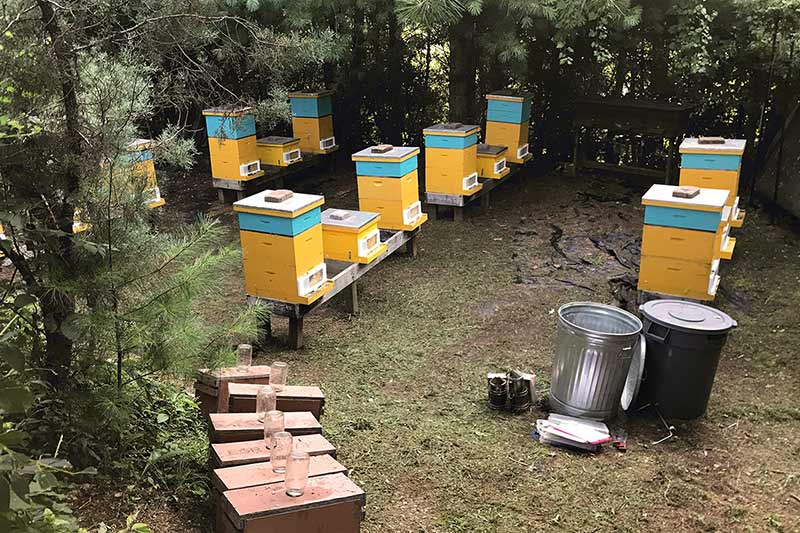When Project Genesis began it was given a home at the WNC Nature Center. The non-treatment hives were placed next to the red wolf habitat, while the treatment hives nestled close by the deer and other ungulates. Both of these locations were safe from vandalism as they rested within locked, twelve foot chain-link fences.


Project Genesis
01Project Genesis is an impressive longitudinal study benefiting the honeybee
Visitors at the WNC Nature Center were able to see the hives from raised boardwalks, with Project Genesis signage. This happy coexistence persisted until the next spring, when a number of hives were knocked over and pillaged by a mother black bear and her three cubs who broke into the Nature Center. As a result, the Nature Center director asked Center for Honeybee Research to relocate the project.
The colonies now reside in West Asheville.
Check our events calendar listing for Volunteer Days with Project Genesis. Please RSVP with your selected dates, and we will confirm your spot, or let you know if we are full, within 2-5 business days.
02The Set-Up
Twenty colonies inhabit identical Langtroth hive bodies in two apiaries (the Upper Yard and Lower Yard), consisting of ten hives each. They are separated by 600 feet; all hives face south. The Upper Yard may in some ways be considered a control group because it remains treatment-free.
The yards are separated to investigate the correlation between mite populations and colony survival.
The Lower Yard is maintained in accordance with currently recommended best management practices: the overwhelming majority of academia and industry pundits view Varroa destructor as the most critical threat to colony survival, and consider the insertion of miticides within colonies as a lesser evil. In contrast, the Upper Yard remains treatment-free.
The 14th season of our ground-breaking study will get underway in March of 2024. If you’d like to volunteer to help in this vital project please submit your information here.
We are proud to say that we have not missed a data-collection since the inception of Center for Honeybee Research. We have PDFs of every inspection form for every hive since then, and hope to make them available online very soon.
03What is a longitudinal study and what do we mean by norms?
Traditional commercial and hobbyist beekeepers continually manipulate their colonies in an effort to ‘strengthen’ or ‘increase production’ through various stratagems, while ‘natural’ beekeeping enthusiasts generally do not record data.
There exists no objective information of the size, production, or longevity honey bee colonies can be expected to achieve on their own. What parameters will a highly successful colony display compared to an average or mediocre one in the same environment? What percentage could be considered exceptional and which poor? How should colonies fare, which are allowed to develop on their own?
We consider Project Genesis unique because it is conducted solely by unpaid volunteers and funded by engaged individuals. Through Dec.of 2023 the Center has conducted bi-weekly inspections for eight complete seasons! We have every inspection sheet from every data-collection dating back to its inception, as well as scanned .pdf files backing them up.
We are still seeking help in establishing a dynamic searchable database where we can post results online in real time. The Center feels this information should be available to anyone in the world without a fee.
04What data is collected?
Protocols have been established and a data-sheet developed for each collection. The colonies are weighed and mite counts taken. Each team inspects every frame in the broodiest of all 20 double-deep Langtroth hive bodies. How many frames have active worker brood? How many have pollen, nectar, or honey without brood? How many frames are drawn but empty? Which box and frame is the Queen found? Is she marked and is that the same as last inspection? (We note how many Queens a colony creates through the course of a season. With few exceptions replacement Queens are generated within Project Genesis itself) Are there Queen Cells started or hatched? Any signs of pests or disease? Anything exceptional or out of the ordinary within the hive? What is in bloom and what colors of pollen are coming in?
Has anything noteworthy occurred during the past two weeks within the surrounding environment: torrential rain, wind, cold, heat or drought? Each data sheet includes the names of the volunteers who conducted the inspection and the date on which it was carried out.





